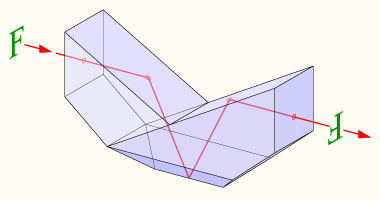.
Abbe-Koenig prism

In this image, the bottom left and right corners of the prism are not needed and have been cut off to reduce weight.
The prism is made from two glass prisms which are optically cemented together to form a symmetric, shallow Vee-shaped assembly. Light enters one face at normal incidence, is internally reflected from a 30° sloped face, and then is reflected from a "roof" section (consisting to two faces meeting at a 90° angle) at the bottom of the prism. The light is then reflected from the opposite 30° face and exits, again at normal incidence.
The net effect of the internal reflections is to flip the image both vertically and horizontally. This produces a 180° image rotation (without changing the image's handedness), and allows use of the prism as an image erecting system. Unlike the more common double Porro prism configuration, the Abbe-Koenig prism does not displace the output beam from the input beam, making it advantageous in some instruments. The prism is also less bulky than the double Porro design.
The prism is sometimes simply called a "roof prism", although this is ambiguous because other roof prisms exist, such as the Amici and Schmidt-Pechan designs.
A variant of the Abbe-Koenig prism replaces the "roof" section of the prism with a single mirror-coated reflecting surface. This type of prism flips the image vertically, but not laterally, changing the handedness of the image to the opposite sense.
Retrieved from "http://en.wikipedia.org/"
All text is available under the terms of the GNU Free Documentation License

